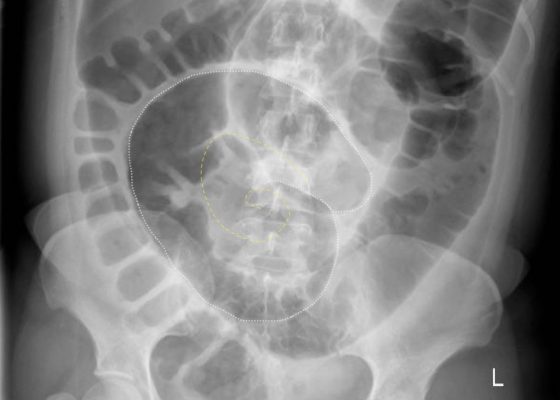Issue 2:3
Corneal Sparing Conjunctival Abrasion
DOI: https://doi.org/10.21980/J8KG93Physical exam was significant for multiple broken teeth, multiple minor abrasions on the face, and fine shards of shattered glass on his face and hair. His right eye had conjunctival injection, with no signs of subconjunctival hemorrhage or ocular penetration. Vision, extraocular movement, and pupillary exam were grossly intact. Fluorescein staining with slit lamp exam with cobalt blue filter examination of the right eye revealed superficial bulbar conjunctival uptake of fluorescein dye staining an area of the conjunctiva inferior to the limbus 5 mm vertical by 2 mm horizontal (estimation by photo provided). No foreign bodies were visualized in the inferior fornix. These findings were consistent with superficial conjunctival abrasion. The exam noted sparing of the corneal epithelium.
Volvulus
DOI: https://doi.org/10.21980/J8JH0QUpright and supine frontal radiographs of the abdomen demonstrate gas dilation of the large bowel from the level of the cecum to the sigmoid colon with air fluid levels (yellow arrows). There is a swirled configuration of the distal descending to sigmoid colon indicating the level of the volvulus (dashed yellow line) and giving rise to the classic “coffee bean” sign (dotted white tracing). Note the elevated left hemidiaphragm on the upright view reflecting abdominal distention with increased intra-abdominal pressure (red arrow).
Pneumonia Diagnosed by Point-of-Care Ultrasound
DOI: https://doi.org/10.21980/J8XP64Point-of-care ultrasound of the left lower lobe demonstrates lung hepatization, a classic finding for pneumonia. In addition, a shred sign is present with both air bronchograms and focal B-lines—all suggestive of poorly aerated, consolidated lung. The patient was started on antibiotics and admitted to the hospital with a diagnosis of community-acquired pneumonia.
Re-expansion Pulmonary Edema
DOI: https://doi.org/10.21980/J8WS6VInitial chest X-ray (chest X-ray 1) showed a right-sided pleural effusion with compressive atelectasis of the mid to lower right lung. Repeat chest X-ray immediately after evacuation (chest X-ray 2) shows improvement of the pleural effusion and a new trace apical right pneumothorax measuring 6.7 mm. When the patient became tachypneic, a third X-ray (chest X-ray 3) showed persistent trace apical right pneumothorax measuring 6.7 mm.
Asymptomatic Wolff-Parkinson-White Syndrome: Incidental EKG
DOI: https://doi.org/10.21980/J8T05XThe ECG shows slurred up-stroking of the QRS complexes characteristic of a delta wave. The PR interval is normal; however, the QT interval is greater than 110ms.
Renal Infarction from Type B Aortic Dissection
DOI: https://doi.org/10.21980/J8HG9GInitial abdominal images demonstrated a dissection flap; therefore, a CTA of the chest was also obtained. These images revealed a Stanford type B aortic dissection beginning just distal to the left subclavian artery and extending to the origin of the inferior mesenteric artery. The right renal artery arose from the true lumen of the dissection while the left renal artery arose from the false lumen. This case is interesting as imaging shows the lack of perfusion to the left kidney, residing in the retroperitoneum, which correlates with her non-descript abdominal and left flank pain.
Esophageal Perforation
DOI: https://doi.org/10.21980/J8K91BHistory of present illness: A 51-year-old male with history of gastroesophageal reflux disease status post multiple endoscopies presented to the emergency department with severe abdominal pain. Paramedics reported the patient appeared diaphoretic on arrival and maintained stable vital signs during transit. The patient reported taking Prilosec that morning before eating breakfast, after which he felt like something was stuck in
Globe Rupture
DOI: https://doi.org/10.21980/J8N91ZThe patient’s computed tomography (CT) head demonstrated a deformed left globe, concerning for ruptured globe. The patient had hyperdense material in the posterior segment (see green arrow), consistent with vitreous hemorrhage. CT findings that are consistent with globe rupture may include a collapsed globe, intraocular air, or foreign bodies.
Steven-Johnson Syndrome
DOI: https://doi.org/10.21980/J8661WAt presentation to the ED, a macular rash was notable on all four extremities, trunk and face, and involved mucous membranes of the oropharynx and vaginal introitus. The rash was painful, erythematous and purpuric with targetoid lesions. There were also multiple areas of sloughing and desquamation with a positive Nikolsky sign. Denudement totaled approximately 2% of total body surface area.
Ectopic Kidney
DOI: https://doi.org/10.21980/J89058CT of the abdomen and pelvis revealed a normal left kidney and an ectopic, malrotated right kidney located in the pelvis (see white arrow).










